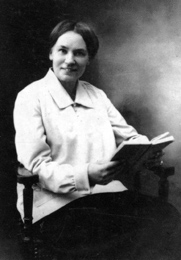
Hedvig Büll was born in the small city of Haapsalu in Estonia, in 1887. Being the daughter of a prosperous family, Hedvig Büll got a good education (higher pedagogical education in Saint Petersburg and missionary education in Germany). She knew her mother tongue Estonian, as well as Russian, French, English, German and also learnt Armenian and Turkish while she was in Cilicia within her missionary activities.
In 1909 Hedvig Büll learnt about the Armenian massacres in Adana from the front pages of the European media and made a fateful decision to leave for a remote country to take part in the saving work of the Christian children who had become orphans as a result of the massacres. In 1911 she arrived in Cilicia and began working as a teacher in the “Beytel” Orphanage of Marash founded by the German Evangelical missionaries for the Armenian parentless children. After working there for four years, in 1915 she became witness to the Armenian massacres carried out by the Young Turk authorities. From 1916 until 1919, Hedvig Büll worked at the German orphanage of Harunie Village (south of Marash), which belonged to the same mission. In 1918 thanks to her superhuman efforts, the young missionary, Hedvig Büll, was able to rescue the children of the orphanage from the Turkish exile and impending disaster. In 1919 taking into account the political situation of Cilicia, Hedvig Büll had to leave for Estonia, but her separation from her favorite Armenian nation did not last long.
The second stage of Hedvig Büll’s Armenophil activity began in 1922. She became a member of the Evangelical Humanitarian Organization called “Christian Mission in the East,” which was established in Strasbourg City and left for Aleppo. There were more than 160.000 refugees at that time in Syria who were mainly sheltered in the huts (the Armenian Camp) built in the suburbs of Suleymanie and Ramatanie and lived in extreme poverty and misery. Many infectious diseases, which were wide spread among the Armenian refuges who were deprived of the basic living conditions, took away hundreds of lives every day. It was urgent to rescue the infected people. A hospital opened in Aleppo on the initiative of Hedvig Büll, where the famous Armenian doctors of Syria (Avetis Jepejyan, Philip Hovnanyan and etc.) began working. The creation of jobs was one of the most important steps to relieve the conditions of the Armenians living in the “Armenian Camp”. Hedvig Büll founded a weaving mill and a handiwork workshop with the support of her good friends of Marash, where more than 500 Armenian women and girls began working. The carpets and handiwork made by these women were sold in the European countries and the profit was given to them as a salary.
On the imitative of Hedvig Büll, scholarships were set for more than 250 Armenian children studying at different schools of Aleppo. She also developed a unique form of adoption, according to which the European benefactor families could adopt only a child from the Armenian refugee family settled in Aleppo and they should send a gold coin to the relatives of the adopted child monthly. The Armenian Community of Aleppo liked Hedvig Büll very much for her Armenophil activity that is why she received honorary title of “Mother Büll”.
In 1947 there was an opportunity for the Armenians all over the world to immigrate to Soviet Armenia. Many Syrian Armenians, including those people who were close to Büll, settled in their Motherland. The cherished dream of an Armenophil Estonian was to settle in Armenia with her Syrian relatives, but the Committee of Immigration denied her petition.
Hedvig Büll devoted entirely 40 years of her life to the Armenian people. In 1951 she left Aleppo at the age of 64 without having her own family, but she could not return to Estonia as it had become a member of Soviet Union and it was impossible to get entry permission. Hedvig Büll settled in Europe, where she continued the correspondence with her children, who did not forget their favorite Mother Büll, though they were scattered all over the world. Hedvig Büll wrote in her letter addressed to one of them: “My Heart is Armenian.”
In 1965 78-year-old Büll again arrived in Syria, and then in Lebanon to take part in the events dedicated to the 50th anniversary of the Armenian Genocide, which were organized in Aleppo and Beirut. Hedvig Büll spent the last years of her life in one of the German retirement homes. The 90-yea-old decrepit woman, lying in death coach had forgotten the six languages she had known well and communicated with the nurses of the retirement home only in Armenian which had become so dear to her. Mother Büll died at the age of 94 on October 3, 1981.
In 2003 the soil taken from the burial site of Hedvig Büll was placed in the “Wall of Memory” of Tsitsernakaberd Memorial Complex.





